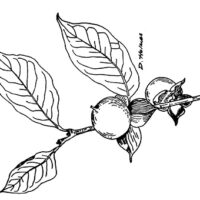 Purdue University - Extension - Forestry and Natural Resources
Purdue University - Extension - Forestry and Natural Resources
Got Nature? Blog
The classic and trusted book “Fifty Common Trees of Indiana” by T.E. Shaw was published in 1956 as a user-friendly guide to local species. Nearly 70 years later, the publication has been updated through a joint effort by the Purdue Department of Forestry and Natural Resources, Indiana 4-H, and the Indiana Department of Natural Resources, and reintroduced as “An Introduction to Trees of Indiana.”
The full publication is available for download for $7 in the Purdue Extension Education Store. The field guide helps identify common Indiana woodlot trees.
Each week, the Intro to Trees of Indiana web series will offer a sneak peek at one species from the book, paired with an ID That Tree video from Purdue Extension forester Lenny Farlee to help visualize each species as it stands in the woods. Threats to species health as well as also insight into the wood provided by the species, will be provided through additional resources as well as the Hardwoods of the Central Midwest exhibit of the Purdue Arboretum, if available. 
This week, we meet the persimmon or Diospyros virginiana, one of Indiana’s fruit producing trees.
The alternately held leaves of persimmon are oval shaped with smooth margins, with no lobes or teeth. The thick dark green leaves turn yellow or reddish-purple in the fall. The buds are dark colored, while leaf stems are light brown.
The bark resembles alligator hide with deep broken ridges, often with an orange coloring between the ridges.
The fruit, a pumpkin orange colored fleshy plum-like fruit, is a standout characteristic and is favored by both wildlife and humans. Once it ripens and falls from the tree, persimmon is soft and sweet. If picked from the tree, this fruit can be green, very hard, gummy in texture and acidic. The seed count in persimmon is variable with some seedless varieties and some with as many as 10 seeds.
Persimmon trees, which grow 35 to 60 feet tall, are native to southern Indiana but can be found planted across the state. This species grows best in full sun and in moist, well-drained soils, but are tolerant of alkaline soil, clay, dry sites, and occasional drought. The natural range of the persimmon is the lower Midwest and southeastern United States reaching up into southern Illinois.
For full article with additional photos view: Intro to Trees of Indiana: Persimmon, Forestry and Natural Resources’ News.
If you have any questions regarding wildlife, trees, forest management, wood products, natural resource planning or other natural resource topics, feel free to contact us by using our Ask an Expert web page.
Other Resources:
Hardwoods of the Central Midwest: Persimmon
ID That Tree: Persimmon
Morton Arboretum: Persimmon
Persimmons, The Education Store
Persimmon, Native Trees of Indiana River Walk, Purdue Fort Wayne
The Woody Plant Seed Manual, U.S. Forest Service
Fifty Common Trees of Indiana
An Introduction to Trees of Indiana
Native Trees of the Midwest, The Education Store
Shrubs and Woody Vines of Indiana and the Midwest, The Education Store
Investing in Indiana Woodlands, The Education Store
Forest Improvement Handbook, The Education Store
ID That Tree, Purdue Extension-Forestry & Natural Resources (FNR) YouTube playlist
Woodland Management Moment , Purdue Extension-FNR YouTube playlist
Wendy Mayer, FNR Communications Coordinator
Purdue University Department of Forestry and Natural Resources
Lenny Farlee, Sustaining Hardwood Extension Specialist
Purdue University Department of Forestry and Natural Resources

Recent Posts
- From Forest to Classroom – 2024 NRTI Class
Posted: July 26, 2024 in Community Development, Forestry, Urban Forestry, Wildlife - Virtual Tour Brings Forest Management for Birds to Life
Posted: July 19, 2024 in Forestry, How To, Publication, Wildlife - Summer Tree Care – Purdue Landscape Report
Posted: July 16, 2024 in Forestry, Forests and Street Trees, How To, Plants, Urban Forestry - DNR State Deer Biologist Shares Population Ecology of Deer-IFWOA Webinar
Posted: July 12, 2024 in Forestry, Wildlife, Woodlands - Buoys Keep Eye on Great Lake Conditions
Posted: July 11, 2024 in Aquatic/Aquaculture Resources, Great Lakes, How To - ID That Tree: Learn to Identify Conifer Leaf Types
Posted: in Forestry, Forests and Street Trees, How To, Urban Forestry, Wildlife - ID That Tree: Types of Broadleaved Tree Leaves
Posted: July 10, 2024 in Forestry, Forests and Street Trees, How To, Plants, Wildlife - 2024 Turkey Brood Count Wants your Observations – MyDNR
Posted: June 28, 2024 in Alert, Community Development, Wildlife - Case Study: Maple Tree Pests – Purdue Landscape Report
Posted: June 26, 2024 in Disease, Forests and Street Trees, Plants, Spiders, Urban Forestry, Wildlife, Woodlands - Woodland Management Moment: Oak Regeneration – Protecting Seedlings
Posted: June 24, 2024 in Forestry, Urban Forestry, Wildlife, Woodland Management Moment, Woodlands
Archives
Categories
- Alert
- Aquaculture/Fish
- Aquatic/Aquaculture Resources
- Ask the Expert
- Christmas Trees
- Community Development
- Disease
- Drought
- Forestry
- Forests and Street Trees
- Gardening
- Got Nature for Kids
- Great Lakes
- How To
- Invasive Animal Species
- Invasive Insects
- Invasive Plant Species
- Land Use
- Natural Resource Planning
- Nature of Teaching
- Plants
- Podcasts
- Ponds
- Publication
- Safety
- Spiders
- Timber Marketing
- Uncategorized
- Urban Forestry
- Webinar
- Wildlife
- Wood Products/Manufacturing
- Woodland Management Moment
- Woodlands